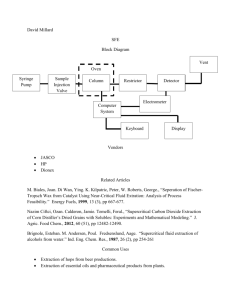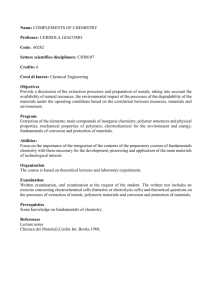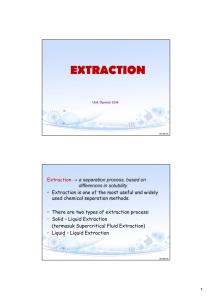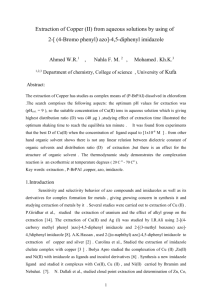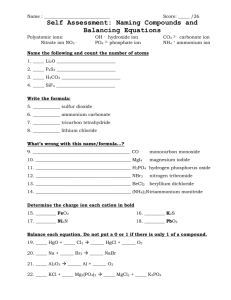Solvent extraction of Zn(II) from Aqueous Sulfate solution by
advertisement
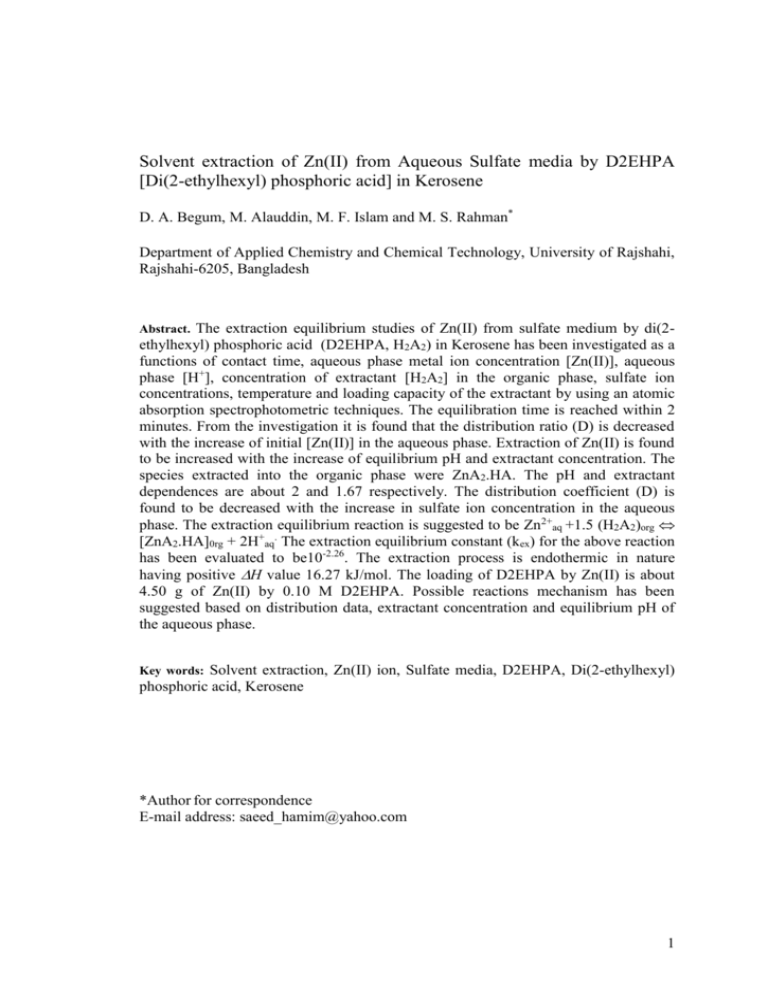
Solvent extraction of Zn(II) from Aqueous Sulfate media by D2EHPA
[Di(2-ethylhexyl) phosphoric acid] in Kerosene
D. A. Begum, M. Alauddin, M. F. Islam and M. S. Rahman*
Department of Applied Chemistry and Chemical Technology, University of Rajshahi,
Rajshahi-6205, Bangladesh
The extraction equilibrium studies of Zn(II) from sulfate medium by di(2ethylhexyl) phosphoric acid (D2EHPA, H2A2) in Kerosene has been investigated as a
functions of contact time, aqueous phase metal ion concentration [Zn(II)], aqueous
phase [H+], concentration of extractant [H2A2] in the organic phase, sulfate ion
concentrations, temperature and loading capacity of the extractant by using an atomic
absorption spectrophotometric techniques. The equilibration time is reached within 2
minutes. From the investigation it is found that the distribution ratio (D) is decreased
with the increase of initial [Zn(II)] in the aqueous phase. Extraction of Zn(II) is found
to be increased with the increase of equilibrium pH and extractant concentration. The
species extracted into the organic phase were ZnA2.HA. The pH and extractant
dependences are about 2 and 1.67 respectively. The distribution coefficient (D) is
found to be decreased with the increase in sulfate ion concentration in the aqueous
phase. The extraction equilibrium reaction is suggested to be Zn2+aq +1.5 (H2A2)org
[ZnA2.HA]0rg + 2H+aq. The extraction equilibrium constant (kex) for the above reaction
has been evaluated to be10-2.26. The extraction process is endothermic in nature
having positive H value 16.27 kJ/mol. The loading of D2EHPA by Zn(II) is about
4.50 g of Zn(II) by 0.10 M D2EHPA. Possible reactions mechanism has been
suggested based on distribution data, extractant concentration and equilibrium pH of
the aqueous phase.
Abstract.
Solvent extraction, Zn(II) ion, Sulfate media, D2EHPA, Di(2-ethylhexyl)
phosphoric acid, Kerosene
Key words:
*Author for correspondence
E-mail address: saeed_hamim@yahoo.com
1
Introduction
Solvent extraction has come out to be one of the most important extraction and
separation processes in hydrometallurgy. Especially phosphorus-based extractant,
D2EHPA is a commercial extractant have proved to be of particular importance, for
its wide range of extraction (from divalent to heptavalent) as well as separation of
metal ions from different acid solutions. The extractant is used by various solvent
extraction chemists for its desirable properties and cost (Sekine, et al., 1977; Islam et
al., 1979; Islam and Biswas, 1979; Islam and Biswas, 1981; Svendsen et al., 1990;
Hancil et al., 1990; Bart et al., 1992; Hughes and Biswas, 1993; Devi et al., 1997 and
Devi et al., 2000). Earlier very few investigations on the extraction of Zn(II) with
D2EHPA were made by some researchers(Sato et al.,1978; Huang and Juang,1986;
George, 1998).
All the studies made on the extraction of Zn(II) by D2EHPA have been done mostly
from chloride and purified D2EHPA medium (Alguacl et al., 1992, Amer and
Luis,1995; Devi et al., 1995). It is also found that almost all the investigations in this
field have carried out with metal ions at trace level of concentrations. As the
extraction characteristics of a metal ion by an extractant depends on the concentration
levels of the metal ion and coexisting anion in the aqueous phase as well as on the
diluents used, the objective of the present work is to make an investigation on the
possibility of extraction of Zn(II) by commercial grade D2EHPA in kerosene system.
Materials and Methods
A standard solution of Zn(II) (1 g/L) was prepared (1 L) by dissolving and diluting
calculated amount of their respective sulfate salts (ZnSO4.7H2O) with distilled water
after adding 2.90 cm3 of 18.337 M H2SO4 and standardized by using an atomic
absorption spectrophotometric method. The test solution was prepared by taking
calculated amount of respective aqueous stock solution of metal ion in a volumetric
flask and then adding calculated amount of sulfate ion as either H2SO4 or Na2SO4 and
made up to the mark by distilled water. After well mixing, the solution was taken in a
beaker for pH adjustment. The pH of the aqueous solution adjusted by using conc.
H2SO4 or anhydrous Na2CO3.
The extractant D2EHPA having 98% purity was used without further purification. All
other chemicals were of reagent grade and used without further purification. The
diluent, kerosene, was purchased from the local market and distilled to collect the
colorless fraction obtained in the range of 200-260°C.
A stock solution of D2EHPA (1 M) was prepared by weighing out exactly 658.02 g of
D2EHPA in a 1 L volumetric flask and diluting with distilled kerosene. Extractant
solutions of different concentrations were prepared by proper dilution of these stock
solutions by distilled Kerosene.
A definite aliquot of an aqueous phase (20 ml) was taken in a 125 ml reagent bottle
and to it same aliquot of organic phase (20 ml) was added. The bottle was stoppered
and shaken for a definite time period in a thermostatic water bath at 30°C (other wise
stated). After attainment of equilibrium, the phases were allowed to settle and
disengaged. The aqueous phase was subjected to equilibrium pH measurement and the
metal ion content by AAS. In all the cases, phase separation occurred readily. The pH
values of the aqueous solutions were measured by Mettler Toledo 320 pH meter. The
equilibrium organic phase metal ion concentrations were estimated by the method of
2
difference. The distribution ratio (D) of a metal ion was calculated as the ratio of
metal ion concentration in the organic phase to that in the aqueous phase at
equilibrium. In the case of loading test, the organic phase was repeatedly contacted
with fresh equal volume of aqueous solutions until the saturation of the organic phase
with the metal was attained.
Results and Discussion
1.
Effect of distribution ratio of Zn(II) by D2EHPA on contact time.
The Fig.1 represents contact time in minutes and the distribution ratio for two
different sets of pH 4 and 5 respectively. In both the cases, it is found that the
extraction ratio of Zn(II) increases continuously with the Increase of phase contact
time up to a period of 2 minutes and then remains unchanged with the further increase
of contact time. The slopes of the lines decrease to zero at around 2 min. Moreover, it
is also observed that about 96.70% and 97.45% of Zn(II) are extracted at pH 4 and 5
respectively, and on further shaking for a long time, extraction ratio is not increased.
The extraction of Zn(II) by Cyanex 302 was studied by ( Alguacil et al.,1992) and
obtained equilibrium time above 10 min. Therefore, the extraction of Zn(II) by
D2EHPA is faster than that of Cyanex 302. It is concluded that the extraction of
Zn(II) from sulfate solution by analytical grade D2EHPA in kerosene system is 2 min.
Thus in subsequent experiments, 5 minutes mixing have been used to ensure
equilibrium.
1.6
1.55
logD
; pH initial = 4
; pH initial = 5
1.5
1.45
1.4
0
5
10
15
20
25
30
35
Contact time (minute)
Fig. 1. Effect of distribution ratio of Zn(II) by D2EHPA on contact time
[Zn(II)]=0.200 g/L, [SO4=](ini)= 0.10 M, pH initial=4.00 and 5.00, phase
mixing time = moderate, [D2EHPA]=0.05 M, O/A = 1, temperature = (30
1)°C.
2.
Effect of metal ion concentration on Zn(II) by D2EHPA.
The results obtained from the experiments are plotted as log D Vs. log
{[Zn(II)](ini)mol/L} which represents the variations of distribution ratio on initial
metal ion concentration. From the study, it is seen that the distribution ratio is
decreased with increasing in initial Zn(II) ion concentration. The slopes of the plots
are steeper at higher concentration region than these at lower concentration. In
3
general, log D should be independent of initial metal ion concentration, provided the
equilibrium pH and the equilibrium extractant concentration remains constant.
2.5
;
;
;
;
2.0
[D2EHPA] = 0.03 M
[D2EHPA] = 0.05 M
[D2EHPA] = 0.10 M
[D2EHPA] = 0.20 M
logD
1.5
1.0
0.5
0.0
-0.5
-1.0
-4
-3
-2
-1
0
log{[Zn(II)]ini,M}
Fig. 2: Effect of distribution ratio (D) on Zn(II) ion concentration. [SO4=](ini)= 0.10
M, pH initial=3.00, phase mixing time = 5 min., [D2EHPA] = 0.05 M, O/A =
1, temperature = (30 1)°C
The decrease in extraction ratio with the increase of Zn(II) ion concentration may be
explained by the following waya) Non constancy of the aqueous phase acidity, pH
With the increase in Zn(II) ion concentration in the aqueous phase, the equilibrium pH
may drop down due to the liberation of H+ by the extraction process. The decreased
equilibrium pH with increase of Zn(II) ion concentration will decrease the extraction
ratio according to the simplified extraction reaction as followsZn2+ + H2A2ZnA2+ 2H+ ...............................................(I)
Where, H2A2 is the dimer of D2EHPA
b) Non- constancy of the equilibrium extractant concentration
With the increase in initial Zn(II) ion concentration, more extractant will be consumed
to form the extractable Zn(II) complex. As a result, the equilibrium pH extractant
concentration will be decreased with the increase in the initial Zn(II) ion
concentration in the aqueous phase and eventually, the extraction ratio will be
decreased as indicated according to the following equationlog D = log Kex+ z log [H2A2](ini) + z pH – S ..................................(II)
4
where,
D = Distribution or extraction ratio, z = Extractant dependence, S = Concentration of
the extractant which is used in forming the metal complex, [H2A2](ini) = Initial
extractant concentration in the organic phase, pH = Equilibrium pH of the aqueous
phase.
Besides these two reasons, the decrease in the extraction ratio with increasing the
initial Zn(II) ion concentration may be attributed to the non-ideality of the aqueous
phase, hydrolysis and polymerization of Zn(II) species in the aqueous phase.
3. Effect of equilibrium pH on the extraction of Zn (II) by D2EHPA.
The results obtained from the experiments at different constant equilibrium pH and at
constant [Zn(II)] concentration are plotted as log D (distribution ratio) Vs equilibrium
pH. This figure shows that the extraction of Zn(II) ions increases with increase of
aqueous phase equilibrium pH. This is the normal characteristics of ion-exchange type
of extraction. The slopes of the lines were calculated and the values are 1.99, 2.09,
2.06, 2.03, 2.12 and 1.96 for 0.01, 0.02, 0.05, 0.10, 0.20 and 0.50 M D2EHPA
systems respectively. The average slope obtained from this investigation is equal to 2
(two). Similar results are obtained from the extraction of Zn(II) by D2EHPA by some
workers (Svendsen et al., 1990; Bart et al., 1992). The intercepts of the lines are 5.58, -5.21, -4.44, -3.80, -3.70 and -2.40 for 0.01, 0.02. 0.05, 0.10, 0.20 and 0.50 M
D2EHPA systems respectively. The slope of the line of Zn(II) is 2, which indicates
that the two moles of H+ is liberated per mole of Zn(II) during extraction. From the
Intercept of the line, the value of extraction equilibrium constant (k ex) was calculated
after knowing the extractant dependence. The calculated value was found to be 10-2.26.
5.0
4.0
logD
3.0
2.0
; [D2EHPA] = 0.01 M, S
= 1.99, I=-5.58
; [D2EHPA] = 0.02 M, S
= 2.09, I=-5.21
; [D2EHPA] = 0.05 M, S
= 2.06, I=-4.44
; [D2EHPA] = 0.10 M, S
= 2.02, I=-3.80
; [D2EHPA] = 0.20 M, S
= 2.12, I=-3.70
; [D2EHPA] = 0.50 M, S
= 1.96, I=-2.40
1.0
0.0
-1.0
-2.0
0
1
2
3
4
5
6
Equilibrium pH
Fig. 3: Effect of distribution ratio (D) on equilibrium pH; [Zn(II)](ini) = 0.215 g / L,
[SO4=](ini) = 0.10 M ,[D2EHPA]= 0.05 M, phase mixing time = 5 min.,
O/A = 1, temperature = (30 1)°C.
5
4. Effect of extractant concentration on the extraction of Zn(II) by D2EHPA.
The results obtained from the experiments at different equilibrium pH and on the
extractant concentration and plotted as log D Vs log [H2A2] and at fixed Zn(II) ion
concentration in Fig. 4. This figure represents the variation of distribution ratio (D) on
the extractant concentrations. It is observed that the extraction ratio is increased with
increasing the extractant concentration in the organic phase, and the straight-line
relationship is obtained. The slopes (S) and intercepts (I) of the lines are S=1.78,
I=2.14; S=1.70, I=3.80; S=1.60, I=5.66 and S=1.60, I=7.82 for equilibrium pH values
of 2, 3, 4, and 5 respectively. Here the linear relationship of the extraction ratio with
the D2EHPA concentration indicates that the more is extractant concentration, the
more is the extraction of Zn(II). This is the normal behavior of extraction process. The
slope of the line indicates that normal ion exchange mechanism for Zn(II) is followed.
Since for a particular initial pH system, the equilibrium pH varies with the variation
of extractant concentration, to get actual extractant dependence, it is necessary to get
log D Vs log [H2A2] plots at constant equilibrium pH values. Such type of correction
has been made with the help of acidity dependence data. First of all the difference
between the initial and equilibrium pH values are determined and it is termed as pH.
As the acidity dependence is always 2, the correction term for log D has been
calculated as pHx2, then the corrected log D value has been calculated to be log D
(experimental)+ pHx2 and this value corresponds to the data at an equilibrium
equaling to initial pH. Average slope of this line is 1.67. Similar observations were
found by some workers ((Svendsen et al., 1990; Bart et al., 1992).
8.0
; Equilibrium pH = 2 ; s = 1.78, I = 2.14
; Equilibrium pH = 3 ; s = 1.70, I = 3.80
6.0
logD
4.0
2.0
0.0
Average slope, s = 1.67
; Equilibrium pH = 4 ; s = 1.60, I = 5.66
; Equilibrium pH = 5 ; s = 1.60, I = 7.82
-2.0
-2.5
-2
-1.5
-1
-0.5
0
log{[D2EHPA],M}
Fig. 4: Effect of distribution ratio (D) on extractant concentration [Zn(II)] (ini) = 0.215
g / L [SO4=](ini) = 0.10 M , phase mixing time = 5 min., O/A = 1,
temperature = (30 1)°C.
Therefore, since extractant dependence of about 1.67, which indicates that the
association of 1.67 moles of extractant with 1 mole of ion Zn(II). From the intercept
of the line in Fig. 3 and 4, the value of log kex has been calculated to be -2.258 with
the standard deviation of log kex being 0.204.
6
Table-1: Evaluation of the extraction equilibrium constant log kex for Zn(II) ion
(Based on Fig. 3 and 4).
Figure
No
Equilibrium
pH
3
4
[D2EHPA],
M
0.01
0.02
0.05
0.10
0.20
0.50
2.0
3.0
4.0
5.0
Intercept, I
Log kex
-5.58
-5.21
-4.44
-3.80
-3.70
-2.40
-2.240
-2.373
-2.267
-2.130
-2.533
-1.897
2.14
3.80
5.66
7.82
-1.94
-2.32
-2.50
-2.38
Average
log kex
Standard
deviation
-2.258
0.204
5. Effect of sulfate ion concentration on the extraction of Zn(II) by D2EHPA.
The results obtained from the experiments involving the variations of sulfate ion
concentration, at three constant initial pH (2, 2 and 3) and at three extractant
concentration (0.05, 0.10 and 0.03 M) respectively and plotted as log D Vs log [SO4=],
M. The variation of extraction ratio with the variation of sulfate ion concentration
depends on the extractant concentration as well as on the pH of the aqueous solution.
When the pH of the aqueous solution kept constant, the extraction ratio decreases with
the increase of sulfate ion concentration in the aqueous phase. In all the cases, the
tangential negative slopes of these curves are increased gradually with the increase of
sulfate ion concentration. At lower sulfate region, the slope approaches to zero,
whereas in the higher region it closes to -2.00 depending upon the pH-D2EHPA
values.
2.0
s = -1.5
1.0
logD
s = -1.7
0.0
-1.0
s = -1.9
; [D2EHPA] = 0.05 M, initial pH = 2
; [D2EHPA] = 0.10 M, initial pH = 2
; [D2EHPA] = 0.03 M, initial pH = 3
-2.0
-1.5
-1
-0.5
0
0.5
=
log{[SO4 ],M}
Fig. 5: Effect of distribution ratio (D) on sulfate ion concentration [Zn(II)] (ini)= 0.215
g/L,
[D2EHPA]=0.05 M, phase mixing time = 5 min., O/A = 1,
temperature = (30 1)°C.
7
6. Effect of temperature on the extraction of Zn(II) by D2EHPA.
The Fig. 6 represents log D vs. inverse of absolute temperature, showing the variation
of distribution ratio on temperature. The effects of temperature on extraction are
shown in this figure. The extraction ratio is increased with increasing temperature.
The slopes of this line are -0.844×103 and -0.857×103 for 0.05 and 0.10 M D2EHPA
in kerosene system respectively. The extraction reaction enthalpy values (H) has
been calculated using Vant-Hoff equation. The calculated values are found to be
16.15 and 16.40 kJ/mol respectively for 0.05 and 0.10 M D2EHPA. The average
value of apparent enthalpy change is 16.27 kJ/mol. The positive enthalpy change
suggests that the extraction process of Zn(II) by D2EHPA is endothermic in nature.
The extraction ratio temperature relationship indicates that the equilibrium reaction of
Zn(II) is moderately influenced by temperature. Thus, extraction of Zn(II) by
D2EHPA in kerosene system is moderately increased by using extraction at a higher
temperature.
2.0
1.8
1.6
1.4
logD
1.2
1.0
0.8
0.6
0.4
; [D2EHPA] = 0.05 M, s = -0.844 10
3
; [D2EHPA] = 0.10 M, s = -0.8570 10
3
0.2
0.0
3
3.2
3.4
(1/TK) × 10
3.6
3
Fig. 6: Effect of distribution ratio (D) on temperature. [Zn(II)] (ini) = 0.205 g / L,
[SO4=](ini) = 0.10 M , pH initial=3.00, phase mixing time = 5 min., O/A
=1.
7. Effect of loading on the extraction of Zn(II) by D2EHPA.
The loading capacity is defined as the amount of metal content in grams extracted per
100 g of an extractant. It is an important factor for the study of mechanism of
extraction and also for the industrial evaluation of the extractant. High values of
loading capacity are desirable for any particular extractant metal system for industrial
applications.
8
5.0
Cumulative [Zn(II)] g/L
; Initial pH = 2
; Initial pH = 3
4.0
3.0
2.0
1.0
0.0
0
5
10
15
No. of contact
Fig. 7: Loading of Zn(II) in D2EHPA. [Zn(II)](ini) = 1.08 g / L [SO4=](ini) = 0.10 M
, phase mixing time = 5 min., [D2EHPA]=0.10 M, O/A = 1, temperature =
(30 1)°C.
The organic phases 20 ml was repeatedly contacted for 5 min at 300C with the fresh
equal volume of aqueous solution containing fixed concentration of metal ions
[Zn(II)] 1.08 g/L at pH 2 and 3. After equilibration, the phases were disengaged and
the aqueous phases were analyzed for Zn(II) contents. The amount of metal ions
[Zn(II)] transferred into the organic phase for each contact was then determined by
difference and the cumulative concentration of Zn(II) in the organic phase after each
stage of contact was estimated. The results obtained from the experiments, plotted as
cumulative [Zn(II)], g/L vs. contact number plot is given in Fig. 7. In this figure, it is
seen that the organic phase is saturated with Zn(II) after 7th and 11th contact for pH 2
and 3 respectively. The loading of Zn(II) by 0.10 M D2EHPA can extracted as much
as 0.92 g and 4.455 g of Zn(II) which indicates that the loading capacity of D2EHPA
is 1.40 and 6.77 g Zn(II) per100 g extractant for pH 2 and 3 respectively. The loading
data suggests that Zn:D2EHPA ratio is = 1, at pH 3, but at pH 2 the Zn : D2EHPA
ratio is very much low. At pH 2 most of D2EHPA remains uncombined having
showed low distribution ratio.
9
Extraction Mechanism:
The extractant dependence of ~1.6 suggests that 1.5 moles of extractant is required
for each ion of Zn(II) ion for the extracted species. The hydrogen ion and extractant
dependence suggests the following equation for the extraction reaction:
Zn2+aq+1.5 (H2A2)org [ZnA2.HA]0rg +2H+aq..........................................(I)
Where the extracted species contains coordinated monomer di-2-ethyl hexyl
phosphoric acid molecules. The extraction of coordinated extracted species (adducts)
is a general observation in the solvent extraction process. The extraction reaction
supported by (Mellah and Benachour, 2006)
The almost zero sulfate dependence below 0.1 M [SO4=] suggests that Zn(II) ion is
the predominant species in the extraction process. However, at higher [SO4=] ion, the
species Zn(HSO4)2 may form to some extent, indicating the reaction involving nonionized zinc species.
Zn(HSO4)2 aq+ 1.5 (H2A2)org [ZnA2.HA]0rg + 2H2SO4 aq....................(II)
Which supports slopes approaching -2.00 with increasing [SO4=] ion concentration in
the aqueous phase.
The loading test suggests that the neutral unreacted HA in the extracted species
[ZnA2.HA] is gradually increased to give Zn : D2EHPA(H2A2) ratio of 1:1
corresponding to the species ZnA2 for high (pH 3) loading. At the low pH the organic
phase is not saturated with zinc even after 11th contact.
Conclusion
Di-2-ethyl hexyl phosphoric acid is a moderately effective extractant for Zn(II) from
low acidic and low sulfate media. The extractant and hydrogen ion dependence
suggests a simple extraction reaction for the process. Temperature has moderate
influence on the extraction process. The extracted species suggested [ZnA2.HA]0rg in
the kerosene phase. However, complete saturation of the organic occurs at high
loading corresponding to ZnA2 as extracted species. The low extraction equilibrium
constant (kex) suggests that the stripping from the organic phase is much favored.
References:
Alguacil, F. J., Cobo, A. Caravaca., C. 1992. Study of the extraction of Zn(II) in the aqueous chloride
media by Cyanex 302. Hydrometallurgy. 31: 163-174.
Amer, S. and Luis, A.1995. The extraction of zinc and other minor metals from concentrated
ammonium chloride solutions with D2EHPA and CYANEX 272 Rev. Metal. 31(6), Pages 351-360
Bart, H. J., Marr, R., Scheks, J. and Konkar, M. 1992. Modelling of solvent extraction equilibria of
Zn(II) from sulfate solutions with bis(2-ethylhexyl) phosphoric acid. Hydrometallurgy. 31: 13-28.
10
Devi, N.B., Nathsamara, K.C. and Chakravorttty, V. 1995. Solvent extraction of zinc(II) using sodium
salts of D2EHPA, PC-88A and CYANEX 272 in kerosene; Proc. Miner. Process. Recent Adv. Future
Trends. pages 537-547.
Devi, N.B., Nathsamara, K.C. and Chakravorttty, V. 1997. Liquid-liquid extraction of manganese (II)
with binary mixtures of sodium salts of D2EHPA, PC-88A and CYANEX 272 :Solvent Extr. Res. Dev.
Pages 117-128
Devi, N.B., Nathsamara, K.C. and Chakravorttty, V. 2000. Separation of divalent manganese and
cobalt ions from sulfate solutions using sodium salts of D2EHPA, PC-88A and CYANEX 272 :
Hydrometallurgy. 54(2-3), Pages 117-131
George O. 1998, Selective extractions of Zn and Cd from Zn-Cd-Co-Ni sulphate solution using di-2ethylhexyl phosphoric acid extractant. Hydrometallurgy.47(2):205–215.
Hancil, V., Slater, M. J. and Yu, W. 1990. On the possible use of di(2 ethylhexyl) phosphoric acid/zinc
as a recommended system for liquid-liquid extraction: the effect of impurities on kinetics.
Hydrometallurgy. 25: 375-386.
Huang, T. Juang, R. 1986. Extraction equilibrium of zinc from sulfate media with bis(2-ethylhexyl)
phosphoric acid. Ind Eng Chem Fundam. 25 (4) 752-757.
Hughes, M. A., and. Biswas, R. K. 1993. The kinetics of Mn(II) extraction in the acidic sulfateD2EHPA-n-hexane system using the rotating diffusion cell technique. Hydrometallurgy. Vol. 32 Pages
209-221.
Islam, F., Rahman, H., and Ali, M. 1979. Solvent extraction separation study of Ti(IV), Fe(III) and
Fe(II) from aqueous solutions with Di-2-ethylhexyl phosphoric acid in benzene. J. Inorg. Nucl. Chem.
Vol. 41, PP. 217-221.
Islam, F., and Biswas, R. K. 1979. The solvent extraction of Cr(III) with Bis(2-ethylhexyl) phosphoric
acid in benzene and other solvents, J. Inorg. Nucl. Chem. Vol. 41, PP. 229-233.
Islam, F., Biswas, R. K 1981. The solvent extraction of Ti(IV), Fe(III) and Mn(II) from acidic sulfateacetate medium with bis(2-ethylhexyl) phosphoric acid in benzene, J Inorg Nucl Chem. 43 1929-1933.
Mellah A., and. Benachour, D. 2006. The solvent extraction of zinc and cadmium from phosphoric acid
solution by di-2-ethyl hexyl phosphoric acid in kerosene diluent; Chemical Engineering and
Processing. Volume 45, Issue 8, Pages 684-69.
Sato, T., Kawamura, M., Nakamura, T., Ueda M. 1978. The solvent extraction of divalent manganese,
iron, cobalt, nickel, copper and zinc from hydrochloric acid solution by di(2-ethylhexyl) phosphoric
acid, J. Appl. Chem. Biotechnol. 28 (2) 85-94.
Sekine, T.Y. Hasegawa, 1977. Solvent Extraction Chemistry: Fundamentals and Application, Marcel
Dekker. New York,
Svendsen, H. F., Schei, G. and Osman, M.1990. Kinetics of extraction of Zinc by di(2- ethylhexyl)
phosphoric acid in cumene. Hydrometallurgy. 25: 197-212.
11
12
